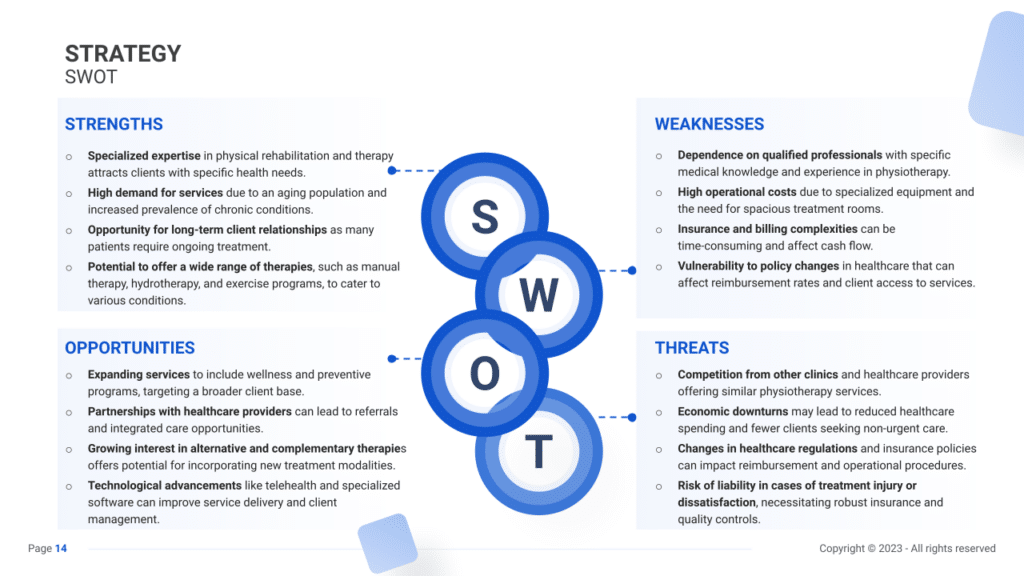How to Prepare a SWOT for a Physiotherapy Clinic

Integral to a physiotherapy clinic’s business plan, a SWOT analysis (Strengths, Weaknesses, Opportunities, Threats) evaluates internal and external factors. Clinic-controlled strengths and weaknesses contrast with external opportunities and threats.
Incorporating a SWOT analysis reveals the clinic’s market position, spotlighting growth and improvement areas. Strengths may include skilled therapists, advanced equipment, and positive patient outcomes, while weaknesses could involve limited services or outdated facilities.
This article will explore diverse examples of strengths and weaknesses, empowering physiotherapy clinic owners with insights for seamless integration into their business plans.

Strengths
- Expert Staff: A physiotherapy clinic’s reputation often hinges on the expertise of its staff.
- Example: Clinicians with advanced certifications can enhance the clinic’s credibility.
- Advanced Equipment: State-of-the-art equipment can significantly improve treatment outcomes.
- Example: Investing in the latest rehabilitation technology can attract patients seeking cutting-edge care.
- Specialized Services: Offering niche therapies can set a clinic apart from competitors.
- Example: Specializing in sports physiotherapy can draw in a dedicated athlete clientele.
- Location: A clinic situated in an accessible area can draw more foot traffic.
- Example: Being located near a sports complex could increase visibility to potential clients.
Weaknesses
- Limited Marketing: Without effective marketing, even the best clinic can go unnoticed.
- Example: A robust online presence can help a clinic reach a wider audience.
- Operational Costs: High-quality services come with significant costs.
- Example: Streamlining operations can reduce expenses without compromising on service quality.
- Patient Retention: Keeping clients engaged post-recovery can be challenging.
- Example: Offering wellness programs can maintain client relationships long-term.
- Insurance Dependencies: Relying heavily on insurance payments can be risky.
- Example: Diversifying payment options can minimize financial vulnerability.
Opportunities
- Wellness Trends: The growing focus on wellness presents new service opportunities.
- Example: Integrating holistic treatments can cater to the wellness-minded demographic.
- Technological Advancements: Digital health innovations offer new ways to deliver care.
- Example: Telehealth services can extend the clinic’s reach beyond its physical location.
- Partnerships: Collaborations with local businesses can expand a clinic’s network.
- Example: Partnering with gyms can provide a steady referral stream.
- Community Programs: Engaging with the community can boost a clinic’s profile.
- Example: Free workshops can showcase the clinic’s expertise and attract new patients.
Threats
- Competition: The rise of new clinics increases the competition for patients.
- Example: Differentiating services can help a clinic stand out in a crowded market.
- Regulatory Changes: Healthcare regulations can impact clinic operations.
- Example: Staying informed about changes can help the clinic adapt swiftly.
- Economic Downturns: Economic instability can affect patients’ ability to pay for services.
- Example: Offering flexible payment plans can help retain clients during tough times.
- Technological Disruptions: New tech can render current treatments obsolete.
- Example: Continual investment in professional development can keep the clinic’s practices current.





